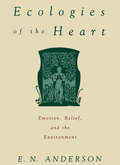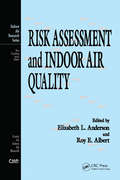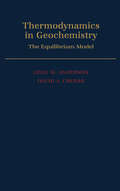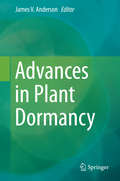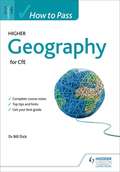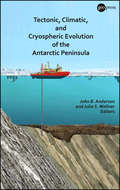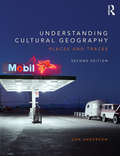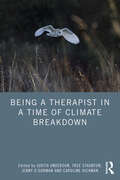- Table View
- List View
Decadal Climate Variability: Dynamics and Predictability (Nato ASI Subseries I: #44)
by David L. T. Anderson Jürgen WillebrandOn decadal time scales, climate change may result not only from man-made causes, but also from natural processes. This book brings together theoretical conceptions of the physical mechanisms of climate change with observational evidence of these changes. The following key topics are included: Observed Climatic Variability, Predictability of the Atmosphere and Oceans from Days to Decades, and Mechanisms for Decadal to Centennial Climate Variability. Further, there are specialised contributions on the role of the oceanic circulation in climate change. The authors are renowned for their pedagogical skills, and the book is primarily designed for beginners in the field, who have a background in physical science. In addition, it is an invaluable source of information for scientists seeking an overview on climate dynamics.
Ecologies Of The Heart: Emotion, Belief, And The Environment
by E. N. AndersonThere is much we can learn about conservation from native peoples, says Gene Anderson. While the advanced nations of the West have failed to control overfishing, deforestation, soil erosion, pollution, and a host of other environmental problems, many traditional peoples manage their natural resources quite successfully. And if some traditional peoples mismanage the environment--the irrational value some place on rhino horn, for instance, has left this species endangered--the fact remains that most have found ways to introduce sound ecological management into their daily lives. Why have they succeeded while we have failed? In Ecologies of the Heart , Gene Anderson reveals how religion and other folk beliefs help pre-industrial peoples control and protect their resources. Equally important, he offers much insight into why our own environmental policies have failed and what we can do to better manage our resources. A cultural ecologist, Gene Anderson has spent his life exploring the ways in which different groups of people manage the environment, and he has lived for years in fishing communities in Hong Kong, Malaysia, Singapore, Tahiti, and British Columbia--as well as in a Mayan farmtown in south Mexico--where he has studied fisheries, farming, and forest management. He has concluded that all traditional societies that have managed resources well over time have done so in part through religion--by the use of emotionally powerful cultural symbols that reinforce particular resource management strategies. Moreover, he argues that these religious beliefs, while seeming unscientific, if not irrational, at first glance, are actually based on long observation of nature. To illustrate this insight, he includes many fascinating portraits of native life. He offers, for instance, an intriguing discussion of the Chinese belief system known as Feng-Shui (wind and water) and tells of meeting villagers in remote areas of Hong Kong's New Territories who assert that dragons live in the mountains, and that to disturb them by cutting too sharply into the rock surface would cause floods and landslides (which in fact it does). He describes the Tlingit Indians of the Pacific Northwest, who, before they strip bark from the great cedar trees, make elaborate apologies to spirits they believe live inside the trees, assuring the spirits that they take only what is necessary. And we read of the Maya of southern Mexico, who speak of the lords of the Forest and the Animals, who punish those who take more from the land or the rivers than they need. These beliefs work in part because they are based on long observation of nature, but also, and equally important, because they are incorporated into a larger cosmology, so that people have a strong emotional investment in them. And conversely, Anderson argues that our environmental programs often fail because we have not found a way to engage our emotions in conservation practices. Folk beliefs are often dismissed as irrational superstitions. Yet as Anderson shows, these beliefs do more to protect the environment than modern science does in the West. Full of insights, Ecologies of the Heart mixes anthropology with ecology and psychology, traditional myth and folklore with informed discussions of conservation efforts in industrial society, to reveal a strikingly new approach to our current environmental crises.
Ecologies of the Heart: Emotion, Belief, and the Environment
by E. N. AndersonThere is much we can learn about conservation from native peoples, says Gene Anderson. While the advanced nations of the West have failed to control overfishing, deforestation, soil erosion, pollution, and a host of other environmental problems, many traditional peoples manage their natural resources quite successfully. And if some traditional peoples mismanage the environment--the irrational value some place on rhino horn, for instance, has left this species endangered--the fact remains that most have found ways to introduce sound ecological management into their daily lives. Why have they succeeded while we have failed? In Ecologies of the Heart, Gene Anderson reveals how religion and other folk beliefs help pre-industrial peoples control and protect their resources. Equally important, he offers much insight into why our own environmental policies have failed and what we can do to better manage our resources. A cultural ecologist, Gene Anderson has spent his life exploring the ways in which different groups of people manage the environment, and he has lived for years in fishing communities in Hong Kong, Malaysia, Singapore, Tahiti, and British Columbia--as well as in a Mayan farmtown in south Mexico--where he has studied fisheries, farming, and forest management. He has concluded that all traditional societies that have managed resources well over time have done so in part through religion--by the use of emotionally powerful cultural symbols that reinforce particular resource management strategies. Moreover, he argues that these religious beliefs, while seeming unscientific, if not irrational, at first glance, are actually based on long observation of nature. To illustrate this insight, he includes many fascinating portraits of native life. He offers, for instance, an intriguing discussion of the Chinese belief system known as Feng-Shui (wind and water) and tells of meeting villagers in remote areas of Hong Kong's New Territories who assert that dragons live in the mountains, and that to disturb them by cutting too sharply into the rock surface would cause floods and landslides (which in fact it does). He describes the Tlingit Indians of the Pacific Northwest, who, before they strip bark from the great cedar trees, make elaborate apologies to spirits they believe live inside the trees, assuring the spirits that they take only what is necessary. And we read of the Maya of southern Mexico, who speak of the lords of the Forest and the Animals, who punish those who take more from the land or the rivers than they need. These beliefs work in part because they are based on long observation of nature, but also, and equally important, because they are incorporated into a larger cosmology, so that people have a strong emotional investment in them. And conversely, Anderson argues that our environmental programs often fail because we have not found a way to engage our emotions in conservation practices. Folk beliefs are often dismissed as irrational superstitions. Yet as Anderson shows, these beliefs do more to protect the environment than modern science does in the West. Full of insights, Ecologies of the Heart mixes anthropology with ecology and psychology, traditional myth and folklore with informed discussions of conservation efforts in industrial society, to reveal a strikingly new approach to our current environmental crises.
The Problem of Time: Quantum Mechanics Versus General Relativity (Fundamental Theories of Physics #190)
by Edward AndersonThis book is a treatise on time and on background independence in physics. It first considers how time is conceived of in each accepted paradigm of physics: Newtonian, special relativity, quantum mechanics (QM) and general relativity (GR). Substantial differences are moreover uncovered between what is meant by time in QM and in GR. These differences jointly source the Problem of Time: Nine interlinked facets which arise upon attempting concurrent treatment of the QM and GR paradigms, as is required in particular for a background independent theory of quantum gravity. A sizeable proportion of current quantum gravity programs - e.g. geometrodynamical and loop quantum gravity approaches to quantum GR, quantum cosmology, supergravity and M-theory - are background independent in this sense. This book's foundational topic is thus furthermore of practical relevance in the ongoing development of quantum gravity programs. This book shows moreover that eight of the nine facets of the Problem of Time already occur upon entertaining background independence in classical (rather than quantum) physics. By this development, and interpreting shape theory as modelling background independence, this book further establishes background independence as a field of study. Background independent mechanics, as well as minisuperspace (spatially homogeneous) models of GR and perturbations thereabout are used to illustrate these points. As hitherto formulated, the different facets of the Problem of Time greatly interfere with each others' attempted resolutions. This book explains how, none the less, a local resolution of the Problem of Time can be arrived at after various reconceptualizations of the facets and reformulations of their mathematical implementation. Self-contained appendices on mathematical methods for basic and foundational quantum gravity are included. Finally, this book outlines how supergravity is refreshingly different from GR as a realization of background independence, and what background independence entails at the topological level and beyond.
Risk Assessment and Indoor Air Quality (Indoor Air Research)
by Elizabeth L. AndersonWith the recent tightening of air quality standards as mandated by the U.S. EPA, has come great pressure on regulatory bodies at all levels of government, along with the industries and groups affected by these standards, to better assess the hazards and risks that result from air pollutants. Risk Assessment and Indoor Air Quality carefully ties tog
Risk Assessment and Indoor Air Quality (Indoor Air Research)
by Elizabeth L. AndersonWith the recent tightening of air quality standards as mandated by the U.S. EPA, has come great pressure on regulatory bodies at all levels of government, along with the industries and groups affected by these standards, to better assess the hazards and risks that result from air pollutants. Risk Assessment and Indoor Air Quality carefully ties tog
Middle East: Geography and Geopolitics
by Ewan AndersonMiddle East is a lively and much-needed update of a well-respected work. Based on W. B. Fisher's book of the same name published in 1978, Anderson provides a comprehensive account of the physical geography which has been so instrumental to the make-up of the geopolitics of the region. The book also covers the sociology, religion, society and economy of the region. With comprehensive illustrations and maps, it provides an excellent synopsis and critique of the complexities which have made this an intriguing and important regional geographical study.
Middle East: Geography and Geopolitics
by Ewan AndersonMiddle East is a lively and much-needed update of a well-respected work. Based on W. B. Fisher's book of the same name published in 1978, Anderson provides a comprehensive account of the physical geography which has been so instrumental to the make-up of the geopolitics of the region. The book also covers the sociology, religion, society and economy of the region. With comprehensive illustrations and maps, it provides an excellent synopsis and critique of the complexities which have made this an intriguing and important regional geographical study.
An Atlas of Middle Eastern Affairs
by Ewan W. Anderson Liam D. AndersonThis revised and updated version of An Atlas of Middle Eastern Affairs provides accessible, concisely written entries on the most important current issues in the Middle East, combining maps with their geopolitical background. Offering a clear context for analysis of key concerns, it includes background topics, the position of the Middle East in the world and profiles of the constituent countries. Features include: Clearly and thematically organised sections covering the continuing importance of the Middle East, the background, fundamental concerns, the states and the crucial issues related to the area. Original maps integrated into the text, placing international issues and conflicts in their geographical contexts. Case studies and detailed analysis of each country, complete with relevant statistics and key facts. Coverage of fundamental considerations, such as: water shortage the petroleum industry conflicts and boundary issues A comprehensive further reading section, enabling students to cover the topic in more depth. Updated to include recent developments such as the "Arab Spring," this book is a valuable introduction to undergraduate students of political science and Middle East studies and is designed as a primary teaching aid for courses related to the Middle East in the areas of politics, history, geography, economics and military studies. This book is also an outstanding reference source for libraries and anyone interested in these fields.
An Atlas of Middle Eastern Affairs
by Ewan W. Anderson Liam D. AndersonThis revised and updated version of An Atlas of Middle Eastern Affairs provides accessible, concisely written entries on the most important current issues in the Middle East, combining maps with their geopolitical background. Offering a clear context for analysis of key concerns, it includes background topics, the position of the Middle East in the world and profiles of the constituent countries. Features include: Clearly and thematically organised sections covering the continuing importance of the Middle East, the background, fundamental concerns, the states and the crucial issues related to the area. Original maps integrated into the text, placing international issues and conflicts in their geographical contexts. Case studies and detailed analysis of each country, complete with relevant statistics and key facts. Coverage of fundamental considerations, such as: water shortage the petroleum industry conflicts and boundary issues A comprehensive further reading section, enabling students to cover the topic in more depth. Updated to include recent developments such as the "Arab Spring," this book is a valuable introduction to undergraduate students of political science and Middle East studies and is designed as a primary teaching aid for courses related to the Middle East in the areas of politics, history, geography, economics and military studies. This book is also an outstanding reference source for libraries and anyone interested in these fields.
Thermodynamics in Geochemistry: The Equilibrium Model
by Greg M. Anderson David A. CrerarThis textbook and reference outlines the fundamental principles of thermodynamics, emphasizing applications in geochemistry. The work is distinguished by its comprehensive, balanced coverage and its rigorous presentation. The authors bring years of teaching experience to the work, and have attempted to particularly address those areas where other texts on the subject have provided inadequate coverage. A thorough review of the necessary mathematics is presented early on, both as a refresher for those with a background in university calculus, and for the benefit of those coming to the subject for the first time. The text is written for students in advanced undergraduate or graduate-level geochemistry as well as for all researchers in this field.
Computational Fluid Dynamics: An Introduction
by J. D. Anderson G. Degrez E. Dick R. GrundmannThis book is an outgrowth of a von Kannan Institute Lecture Series by the same title first presented in 1985 and repeated with modifications in succeeding years. The objective, then and now, was to present the subject of computational fluid dynamics (CFD) to an audience unfamiliar with all but the most basic aspects of numerical techniques and to do so in such a way that the practical application ofCFD would become clear to everyone. Remarks from hundreds of persons who followed this course encouraged the editor and the authors to improve the content and organization year by year and eventually to produce the present volume. The book is divided into two parts. In the first part, John Anderson lays out the subject by first describing the governing equations offluid dynamics, concentration on their mathematical properties which contain the keys to the choice of the numerical approach. Methods of discretizing the equations are discussed next and then transformation techniques and grids are also discussed. This section closes with two examples of numerical methods which can be understood easily by all concerned: source and vortex panel methods and the explicit method. The second part of the book is devoted to four self-contained chapters on more advanced material: Roger Grundmann treats the boundary layer equations and methods of solution; Gerard Degrez treats implicit time-marching methods for inviscid and viscous compressible flows, and Eric Dick treats, in two separate articles, both finite-volume and finite-element methods.
Advances in Plant Dormancy
by James V. AndersonPlant dormancy involves synchronization of environmental cues with developmental processes to ensure plant survival; however, negative impacts of plant dormancy include pre-harvest sprouting, non-uniform germination of crop and weed seeds, and fruit loss due to inappropriate bud break. Thus, our continued quest to disseminate information is important in moving our understanding of plant dormancy forward and to develop new ideas for improving food, feed, and fiber production and efficient weed control, particularly under global climate change. Proceeding from the 5th International Plant Dormancy Symposium will provide an overview related on our current understanding of how environmental factors impact cellular, molecular, and physiological processes involved in bud and seed dormancy, and perspectives and/or reviews on achievements, which should stimulate new ideas and lines of investigation that increase our understanding of plant dormancy and highlight directions for future research.
How to Pass Higher Geography for CfE (PDF)
by John AndersonGet your best grade with this guide to Higher Geography for CfE. This book contains all the advice and support you need to revise successfully for your Higher (for CfE) exam. It combines an overview of the course syllabus with advice from a top expert on how to improve exam performance, so you have the best chance of success.
Tectonic, Climatic, and Cryospheric Evolution of the Antarctic Peninsula (Special Publications #63)
by John B. Anderson Julia S. WellnerPublished by the American Geophysical Union as part of the Special Publications Series. Tectonic, Climatic, and Cryospheric Evolution of the Antarctic Peninsula presents the analysis of data collected during the SHALDRIL program, which sampled the most complete Cenozoic stratigraphic section in the Antarctic Peninsula. The stratigraphic intervals sampled fill major gaps in the existing stratigraphic record in the region, which is believed to have been the last place in Antarctica to become fully glaciated and, as such, the last refugium for plants and animals living on the continent. Providing previously unpublished results from studies aimed at improving our understanding of the changes in climate, glacial setting, and fauna and flora that took place over the past 30 million years, the volume highlights include discussions of marine seismic and drill core records documenting the initial growth and expansion of an ice sheet across the northernmost Antarctic Peninsula continental shelf in the northwestern Weddell Sea. The book features: Detailed vegetation and phytoplankton evolution from greenhouse through icehouse conditions in Antarctica's last refugium Sand grain texture and micromorphology indicating ice sheet control of weathering style Exhumational history around the Drake Passage margins from thermochronology and sediment provenance Comprehensive review of the opening of the ocean passageway between Antarctica and South America and the associated regional tectonics. Tectonic, Climatic, and Cryospheric Evolution of the Antarctic Peninsula will be of interest to geologists, climatologists, and glaciologists interested in climate and cryosphere evolution and those factors that regulate it.
Tectonic, Climatic, and Cryospheric Evolution of the Antarctic Peninsula (Special Publications #63)
by John B. Anderson Julia S. WellnerPublished by the American Geophysical Union as part of the Special Publications Series. Tectonic, Climatic, and Cryospheric Evolution of the Antarctic Peninsula presents the analysis of data collected during the SHALDRIL program, which sampled the most complete Cenozoic stratigraphic section in the Antarctic Peninsula. The stratigraphic intervals sampled fill major gaps in the existing stratigraphic record in the region, which is believed to have been the last place in Antarctica to become fully glaciated and, as such, the last refugium for plants and animals living on the continent. Providing previously unpublished results from studies aimed at improving our understanding of the changes in climate, glacial setting, and fauna and flora that took place over the past 30 million years, the volume highlights include discussions of marine seismic and drill core records documenting the initial growth and expansion of an ice sheet across the northernmost Antarctic Peninsula continental shelf in the northwestern Weddell Sea. The book features: Detailed vegetation and phytoplankton evolution from greenhouse through icehouse conditions in Antarctica's last refugium Sand grain texture and micromorphology indicating ice sheet control of weathering style Exhumational history around the Drake Passage margins from thermochronology and sediment provenance Comprehensive review of the opening of the ocean passageway between Antarctica and South America and the associated regional tectonics. Tectonic, Climatic, and Cryospheric Evolution of the Antarctic Peninsula will be of interest to geologists, climatologists, and glaciologists interested in climate and cryosphere evolution and those factors that regulate it.
Directions in Strong Motion Instrumentation: Proceedings of the NATO SFP Workshop on Future Directions in Instrumentation for Strong Motion and Engineering Seismology, Kusadasi, Izmir, May 17-21, 2004 (Nato Science Series: IV: #58)
by John G. Anderson Polat GülkanStrong ground motion measuring and recording instruments play a major role in mitigation of seismic risk. The strong ground motion near the source of an earthquake describes the effects that endanger our built environment, and is also the most detailed clue concerning the source mechanism of the earthquake. The range of complexity that engulfs our understanding of the source parameters of a major earthquake (extent of the source mechanism, stress drop, wave propagation patterns) and how buildings and other works of construction respond to ground-transmitted dynamic effects may be overpowered by improved direct observations. Strong motion seismographs provide the information that enables scientists and engineers to resolve the many issues that are intertwined with practical problems of building safe communities worldwide. They may be installed as arrays close to major fault zones, consisting of many instruments arranged in some geometrical pattern, or in the vicinity and mounted on buildings. This book, which contains papers by invited authorities, represents a unique interaction between seismologists and earthquake engineers who examine issues of mutual concern in an overlapping area of major interest. The papers have been grouped around three major areas.-Seismic Hazard and Extreme Motions -Engineering Uses of Strong Motion Seismograms -Arrays and Observations.
Surfing Spaces (Routledge Research in Culture, Space and Identity)
by Jon AndersonThe act of surfing involves highly-skilled humans gliding, sliding, or otherwise riding waves of energy as they pass through water. As this book argues, however, this act of surfing does not exist in isolation. It is defined by the cultures and geographies that synergize with it – by the places, ideas, images, and other representations which at once reflect, create, and commodify this spatial practice. This book innovatively explores the spaces of surf and surf-riding, informed specifically by the perspective of human geography. Based on a range of critical turns within the social sciences, the book explores the locations, relational sensibilities, and transformative nature of surfing spaces, and examines how the spatial practice has been scripted by dominant surfing cultures. The book details how prescriptive (b)orders of access, entitlement, and marginalization have been created, and how, with the advent of new craft, media, and ideals, they are being actively challenged to redefine surfing spaces in the twenty-first century.
Surfing Spaces (Routledge Research in Culture, Space and Identity)
by Jon AndersonThe act of surfing involves highly-skilled humans gliding, sliding, or otherwise riding waves of energy as they pass through water. As this book argues, however, this act of surfing does not exist in isolation. It is defined by the cultures and geographies that synergize with it – by the places, ideas, images, and other representations which at once reflect, create, and commodify this spatial practice. This book innovatively explores the spaces of surf and surf-riding, informed specifically by the perspective of human geography. Based on a range of critical turns within the social sciences, the book explores the locations, relational sensibilities, and transformative nature of surfing spaces, and examines how the spatial practice has been scripted by dominant surfing cultures. The book details how prescriptive (b)orders of access, entitlement, and marginalization have been created, and how, with the advent of new craft, media, and ideals, they are being actively challenged to redefine surfing spaces in the twenty-first century.
Understanding Cultural Geography: Places and traces
by Jon AndersonUnderstanding Cultural Geography: Places and Traces offers a comprehensive introduction to perhaps the most exciting and challenging area of human geography. By focusing on the notion of ‘place’ as a key means through which culture and identity is grounded, the book showcases the broad range of theories, methods and practices used within the discipline. This book not only introduces the reader to the rich and complex history of cultural geography, but also the key terms on which the discipline is built. From these insights, the book approaches place as an ‘ongoing composition of traces’, highlighting the dynamic and ever-changing nature of the world around us. The second edition has been fully revised and updated to incorporate recent literature and up-to-date case studies. It also adopts a new seven section structure, and benefits from the addition of two new chapters: Place and Mobility, and Place and Language. Through its broad coverage of issues such as age, race, scale, nature, capitalism, and the body, the book provides valuable perspectives into the cultural relationships between people and place. Anderson gives critical insights into these important issues, helping us to understand and engage with the various places that make up our lives. Understanding Cultural Geography is an ideal text for students being introduced to the discipline through either undergraduate or postgraduate degree courses. The book outlines how the theoretical ideas, empirical foci and methodological techniques of cultural geography illuminate and make sense of the places we inhabit and contribute to. This is a timely update on a highly successful text that incorporates a vast foundation of knowledge; an invaluable book for lecturers and students.
Understanding Cultural Geography: Places and traces
by Jon AndersonUnderstanding Cultural Geography: Places and Traces offers a comprehensive introduction to perhaps the most exciting and challenging area of human geography. By focusing on the notion of ‘place’ as a key means through which culture and identity is grounded, the book showcases the broad range of theories, methods and practices used within the discipline. This book not only introduces the reader to the rich and complex history of cultural geography, but also the key terms on which the discipline is built. From these insights, the book approaches place as an ‘ongoing composition of traces’, highlighting the dynamic and ever-changing nature of the world around us. The second edition has been fully revised and updated to incorporate recent literature and up-to-date case studies. It also adopts a new seven section structure, and benefits from the addition of two new chapters: Place and Mobility, and Place and Language. Through its broad coverage of issues such as age, race, scale, nature, capitalism, and the body, the book provides valuable perspectives into the cultural relationships between people and place. Anderson gives critical insights into these important issues, helping us to understand and engage with the various places that make up our lives. Understanding Cultural Geography is an ideal text for students being introduced to the discipline through either undergraduate or postgraduate degree courses. The book outlines how the theoretical ideas, empirical foci and methodological techniques of cultural geography illuminate and make sense of the places we inhabit and contribute to. This is a timely update on a highly successful text that incorporates a vast foundation of knowledge; an invaluable book for lecturers and students.
Understanding Cultural Geography: Places and Traces
by Jon AndersonThis book outlines how the theoretical ideas, empirical foci, and methodological techniques of cultural geography make sense of the ‘culture wars’ that define our time. It is on the battleground of culture that our opportunities, rights, and futures are determined and Understanding Cultural Geography showcases how this discipline can be used to understand these battles and how we can engage in them. Through doing so, the book not only introduces the reader to the rich and complex history of cultural geography, but also the key terms on which the discipline is built. From these insights, the text approaches place as an ‘ongoing composition of traces’, highlighting the dynamic and ever-changing nature of the world around us, and what our role can be in transforming it for the better. The third edition has been fully revised and updated to incorporate recent literature and reflect the changing cultural context of its time. Retaining its exciting and innovative structure, the third edition will expand its focus into new areas, including updated chapters on ethnicity and race, and new chapters on gender and the body. This new edition captures not only recent changes in the cultural world, but also the discipline itself, offering the most up-to-date text to understand and engage with the cultural battlegrounds which constitute our lives. Understanding Cultural Geography is the ideal text for students being introduced to the discipline through either undergraduate or postgraduate degree courses. The third edition is an important update to a highly successful text that incorporates a vast foundation of knowledge; it is an invaluable book for lecturers and students.
Understanding Cultural Geography: Places and Traces
by Jon AndersonThis book outlines how the theoretical ideas, empirical foci, and methodological techniques of cultural geography make sense of the ‘culture wars’ that define our time. It is on the battleground of culture that our opportunities, rights, and futures are determined and Understanding Cultural Geography showcases how this discipline can be used to understand these battles and how we can engage in them. Through doing so, the book not only introduces the reader to the rich and complex history of cultural geography, but also the key terms on which the discipline is built. From these insights, the text approaches place as an ‘ongoing composition of traces’, highlighting the dynamic and ever-changing nature of the world around us, and what our role can be in transforming it for the better. The third edition has been fully revised and updated to incorporate recent literature and reflect the changing cultural context of its time. Retaining its exciting and innovative structure, the third edition will expand its focus into new areas, including updated chapters on ethnicity and race, and new chapters on gender and the body. This new edition captures not only recent changes in the cultural world, but also the discipline itself, offering the most up-to-date text to understand and engage with the cultural battlegrounds which constitute our lives. Understanding Cultural Geography is the ideal text for students being introduced to the discipline through either undergraduate or postgraduate degree courses. The third edition is an important update to a highly successful text that incorporates a vast foundation of knowledge; it is an invaluable book for lecturers and students.
Being a Therapist in a Time of Climate Breakdown
by Judith Anderson Tree Staunton Jenny O’Gorman Caroline HickmanThis book introduces readers to the known psychological aspects of climate change as a pressing global concern and explores how they are relevant to current and future clinical practice.Arguing that it is vital for ecological concerns to enter the therapy room, this book calls for change from regulatory bodies, training institutes and individual practitioners. The book includes original thinking and research by practitioners from a range of perspectives, including psychodynamic, eco-systemic and integrative. It considers how our different modalities and ways of working need to be adapted to be applicable to the ecological crises. It includes Voices from people who are not practitioners about their experience including how they see the role of therapy. Chapters deal with topics from climate science, including the emotional and mental health impacts of climate breakdown, professional ethics and wider systemic understandings of current therapeutic approaches. Also discussed are the practice-based implications of becoming a climate-aware therapist, eco-psychosocial approaches and the inextricable links between the climate crises and racism, colonialism and social injustice. Being a Therapist in a Time of Climate Breakdown will enable therapists and mental health professionals across a range of modalities to engage with their own thoughts and feelings about climate breakdown and consider how it both changes and reinforces aspects of their therapeutic work.

